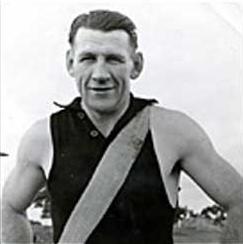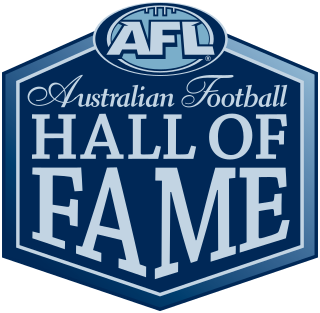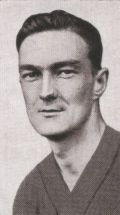Related Research Articles

John Raymond Dyer Sr. OAM, nicknamed Captain Blood, was an Australian rules footballer who played for the Richmond Football Club in the Victorian Football League (VFL) between 1931 and 1949. One of the game's most prominent players, he was one of 12 inaugural "Legends" inducted into the Australian Football Hall of Fame. He later turned to coaching and work in the media as a popular broadcaster and journalist.

Leigh Raymond Matthews is a former Australian rules footballer and coach. He played for Hawthorn in the Victorian Football League (VFL) and coached Collingwood and the Brisbane Lions in the VFL and renamed Australian Football League (AFL).
Barry James Round was an Australian rules footballer. He played for Footscray and South Melbourne/Sydney in the Victorian Football League (VFL) between 1969 and 1985. He played 328 games, won a Brownlow Medal in 1981 and was the Swans' first captain during the Sydney era. Round's height and weight was 193 cm and 108 kg.

Haydn William Bunton was an Australian rules footballer who represented Fitzroy in the Victorian Football League (VFL), Subiaco in the West Australian Football League (WAFL), and Port Adelaide in the South Australian National Football League (SANFL) during the 1930s and 1940s.
Keith Southby Greig is a former Australian rules footballer who played for the North Melbourne Football Club in the Victorian Football League (VFL).

The Australian Football Hall of Fame was established in 1996, the centenary year of the Australian Football League, to help recognise the contributions made to the sport of Australian rules football by players, umpires, media personalities, coaches and administrators. It was initially established with 136 inductees. As of 2023, this figure has grown to more than 300, including 31 "Legends". There had previously been 32 official Legends, but disgraced player Barry Cable had his football honours rescinded after being found guilty of historical child sex abuse.
The Bob Skilton Medal is an annual Australian rules football award presented to the player(s) adjudged the best and fairest at the Sydney Swans throughout the Victorian Football League/Australian Football League (VFL/AFL) season. It is named after Bob Skilton, who won the award a record nine times from 1958 to 1968. The voting system as of the 2017 AFL season, consists of five coaches giving an undetermined number of players up to ten votes each after every match. Players can receive a maximum of 50 votes for a game.
David Cloke is a former Australian rules footballer who played for the Richmond Football Club and the Collingwood Football Club in the Australian Football League (AFL).

Verdun John Howell is a former Australian rules footballer who played senior football in Tasmania and in the VFL.

Leslie Roy Foote was an Australian rules footballer in the Victorian Football League.
Peter Lawrence Anthony "Wheels" Bedford is a former Australian rules footballer and first-class cricketer. As a footballer, he is best known for his time at South Melbourne, where he won Victorian Football League's (VFL's) Brownlow Medal in 1970 as the fairest and the best in the competition.

Desmond Hugh Fothergill was an Australian rules footballer who played for Collingwood Football Club in the Victorian Football League (VFL) and for Williamstown Football Club in the Victorian Football Association (VFA). He was also a noted cricketer, representing Victoria in the Sheffield Shield.

James William McLaren Morris was an Australian rules footballer who played for Richmond in the Victorian Football League (VFL), mostly during the 1940s. He played much of his football beside Jack Dyer as a knock ruckman.

Colin Edward 'Col' Austen was an Australian rules footballer who played for the Hawthorn Football Club and Richmond Football Club in the Victorian Football League (VFL).
Harold Peter "Hassa" Mann is a former Australian rules footballer who played for and captained Melbourne in the VFL during the 1960s. He earned the name Hassa when he was a toddler, from his cousin and future Melbourne footballer Len Mann.

Robert C. Johnson was an Australian rules footballer who played for Melbourne in the Victorian Football League (VFL). His son Bob followed in his footsteps and played for the club in the 1950s.

Francis Charles "Frank" Johnson was an Australian rules footballer who played for the South Melbourne Football Club in the Victorian Football League (VFL) and Port Melbourne in the Victorian Football Association (VFA).
Maxwell William Papley is a former Australian rules footballer who represented South Melbourne in the Victorian Football League (VFL) and Moorabbin and Williamstown in the Victorian Football Association (VFA) during the 1950s and 1960s.

Ernest Benjamin 'Tich' Utting was an Australian rules footballer who played for the Collingwood Football Club and Hawthorn Football Club in the Victorian Football League (VFL).

Edward James Whitten Sr. OAM was an Australian rules footballer who played for the Footscray Football Club in the Victorian Football League (VFL).
References
- ↑ "Bobby Skilton elevated to Legend in the Sport Australia Hall of Fame". 13 September 2023.
- ↑ "Wedding Bells", The Record (Emerald Hill), 19 November 1932, p. 7.
- ↑ The VFA Project: Bob Skilton; The Players, The (Emerald Hill) Record, (Saturday, 11 September 1926), p.2.
- ↑ Ex-Footballer P.O.W., The Sporting Globe, (Saturday, 15 May 1943), p. 3; [https://www.awm.gov.au/collection/R1466091 Second World War POWs and Missing Persons: Sergeant R. H. Skilton (VX40915), Australian War Memorial; The Australian Ex-Prisoners of War Memorial, Ballarat, Victoria. Archived 9 March 2020 at the Wayback Machine
- ↑ Rivett, R.D., "Appalling Ordeal of Prisoners on 'Death Railway': Jap Persecution and Brutality", The Argus, 13 September 1945, p. 20.
- ↑ "Deaths: Skilton", The Age, 16 July 1987, p. 24.
- ↑ Beames, Percy, "Intense Training Behind Medal Win", The Age, 3 September 1959 , p. 24.
- ↑ "Made Quick Recovery", The Age, 12 June 1961, p. 14.
- ↑ A manoeuvre where a player holds the ball out to the side in one hand (e.g., ), then brings the ball back to the chest, and runs in the other direction. The move is performed to evade a defender, who will attack in the ball's original direction rather than the ball and player's subsequent direction. It is an entirely different ploy from a "dummy" pass. Other noted exponents of the "baulk" manoeuvre were Les Foote and Kevin Sheedy.
- ↑ The stab kick has now all but disappeared from AFL football.
- ↑ "Vic. Boys Led Rest at Rules", The Truth (Brisbane), 2 August 1953, p.17.
- ↑ Family Affair, The Argus, (Wednesday, 29 February 1956), p.26.
- ↑ "Legend No.10: Bobby Skilton". Real Footy.
- ↑ Hobbs, Greg, "Bob Skilton is New Coach of South", The Age, (Wednesday, 23 September 1964), p.24.
- 1 2 "Bob Skilton OAM Elevated to Legend Status | Sport Australia Hall of Fame". 13 September 2023. Retrieved 3 October 2023.
- ↑ Lusted, P., "Football great Bob Skilton receives Queen's Birthday honour", ABC News, 11 June 2018.